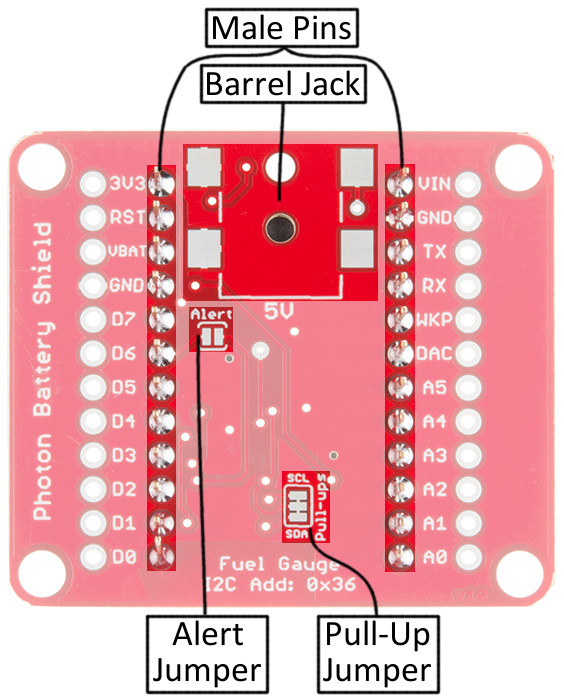Photon Battery Shield Hookup Guide
Contributors:
 jimblom
jimblom
Battery Shield Overview
Let's do a quick rundown of the Photon Battery Shield's hardware features. Here are some highlights of the board's main components:
- LiPo Connector (PH-Series JST) -- The battery goes here. This connector is polarized, so it'll only plug in the right way.
- Photon Socket -- Each Photon comes pre-soldered with male headers, so all of our shields come pre-populated with female connectors on their top-side.
- Photon Pin Breakouts -- Need more access to the Photon's I/O? These pin break-outs have that covered. These break outs are in the same place on each of our Photon Shields -- should you need to interface them together that way.
- Photon Polarity Indicator -- Nothing's going to work if your Photon isn't plugged in correctly. These angled edges should match up to those on the Photon's PCB.
- Charge LED Indicator -- This red LED will light up whenever the LiPo battery is being charged.
Flipping the Shield over reveals a few, less commonly-used features of the board:
- "Stackable" Male Pins -- Whether you want to plug the battery shield into more Photon shields, or use it in a breadboard, these male pins should do the job. If you don't need this feature, the pins can all be quickly beheaded by some flush cutters.
- SMD Barrel Jack footprint -- This footprint allows you to add an SMD Barrel Jack to the Battery Shield's underside. This'll allow you to charge the battery with a 5V Wall Adapter, or even a Small Solar Panel. Just make sure your power source isn't higher than 5.5V.
- I2C Pull-up Resistor Enable/Disable -- The Photon Battery Shield includes a pair of 10kΩ pull-up resistors on the SDA and SCL lines (D0 and D1). If you've got more I2C devices to connect, you may need to disable those. These jumpers are closed by default, but can be opened with a couple slices of a hobby knife.
- Alert Interrupt Jumper -- The MAX17043 features a programmable interrupt output, which can fire whenever your battery gets below a set percentage of charge. This pin can be connected to the Photon's D6 pin by adding a blob of solder between these two pads. Note that this jumper is open by default, as other shields make use of D6.

